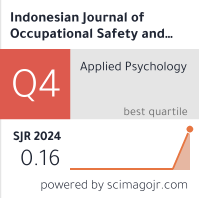Dysmenorrhea and Seborrheic Dermatitis due to Occupational Stress Among Female Bank Workers

Downloads
Introduction: Bank workers who provide services to customers are required to have an optimal performance. They are vulnerable to stress that can interfere with their performance. Stress causes an increase in sebaceous glands, resulting in seborrheic dermatitis and an increase in hormones. This can cause contraction of the uterine muscles which can lead to dysmenorrhea. This study aims to determine the relationship between occupational stress and dysmenorrhea and seborrheic dermatitis among female bank workers. Methods: This research followed an analytic observational cross-sectional design using primary data from female workers at SumSel Babel Bank A. Rivai Branch. The sample consisted of 75 female bank workers, who met the inclusion and exclusion criteria and were selected using consecutive sampling. The independent variable in this study was occupational stress, while the dependent variables were dysmenorrhea and seborrheic dermatitis. Data were collected from primary data, the workplace stress scale questionnaire for occupational stress, the WaLIDD score for dysmenorrhea, and seborrheic dermatitis examination by a dermatologist. After obtaining the data, bivariate analysis was performed using the Chi-square test. Results: Sixty respondents (80%) had occupational stress, 47 respondents (62.7%) experienced dysmenorrhea, and 69 respondents (92%) did not experience seborrheic dermatitis. The results of statistical tests showed that there was a relationship between occupational stress and dysmenorrhea in female bank workers with a p-value 0.000 and no significant relationship between stress and the incidence of seborrheic dermatitis with p-value 0.202. Conclusion: Occupational stress can cause health problems including dysmenorrhea in female workers.
Abreu-Sánchez, A. et al. (2020) ‘Type of Dysmenorrhea, Menstrual Characteristics and Symptoms in Nursing Students in Southern Spain', Healthcare (Switzerland), 8(3).
Amrianah, H. (2019) ‘Pengaruh Stres Kerja Terhadap Kinerja Pegawai Pada Kantor Bank Sulselbar Cabang Barru', Meraja Journal, 2(1), pp. 13–34.
Argirov, A. and Bakardzhiev, I. (2017) ‘New Insights into the Etiopathogenesis of Seborrheic Dermatitis', Journal of Clinical Research in Dermatology, 4(1), pp. 1–5.
BPS (2023) Persentase Tenaga Kerja Formal Menurut Jenis Kelamin (Persen), 2020-2022.
Dewi, N.P. (2022) ‘Aspek Klinis Dermatitis Seboroik', Cermin Dunia Kedokteran, 49(6), pp. 327–331.
Gül, A.Ä°., Karaaslan, Ö. and Çölgeçen, E. (2017) ‘Personality Traits and Common Psychiatric Conditions in Patients with Seborrheic Dermatitis', Revista de Psiquiatria Clinica, 44(1), pp. 6–9.
Hidayati, L.N. and Harsono, M. (2021) ‘Tinjauan Literatur Mengenai Stres Dalam Organisasi', Jurnal Ilmu Manajemen, 18(1), pp. 20–30.
Horman, N., Manoppo, J. and Meo, L.N. (2021) ‘Faktor-Faktor Yang Berhubungan Dengan Kejadian Dismenore Primer Pada Remaja Puteri di Kabupaten Kepulauan Sangihe.', Jurnal Keperawatan, 9(1), pp. 38–47.
Iis, I. and Rohaeni, E. (2022) ‘Hubungan Status Gizi Dengan Kejadian Disminore Pada Remaja Putri', Indonesian Health Journal, 1(1), pp. 15–22.
Al Juman, A.A. et al. (2021) ‘Review on Seborrheic Dermatitis Diagnosis and Treatment in Primary Health Care Center', Archives Of Pharmacy Practice, 12(4), pp. 35–37.
Kalalo, J.V.D., Pandeleke, H.E.J. and Gaspersz, S. (2019) ‘Hubungan Penggunaan Hair Styling terhadap Kejadian Dermatitis Seboroik pada Mahasiswa Laki-laki di Fakultas Kedokteran', Jurnal e-Clinic (eCl), 7(1), pp. 7–11.
Karim, K. and Tajibu, M.J. (2018) ‘Keterkaitan Usia dan Iklim Organisasi terhadap Prestasi Kerja Karyawan Bank di Makassar', SEIKO Journal of Management & Business, 2(1), pp. 73–91.
Khaeriyah, M. (2018) Gambaran Tingkat Stres Kerja pada Karyawan Bank Rakyat Indonesia (BRI) Cabang Watansoppeng Tahun 2018. Makassar: Faculty of Medicine and Health Scineces Universitas Islam Negeri Alauddin Makassar.
Laeli Widodo, N. and Sukarno, G. (2021) ‘Pengaruh Stres Kerja dan Konflik Wanita Peran Ganda Pada Aspirasi Karir Pada Pekerja Wanita di Lingkungan PT Pertamina Asset 4 Surabaya', JIMEA, 5(3).
Mantolas, S.L., Sri Nurwela, T. and Gerontini, R. (2019) ‘Hubungan Tingkat Stres Dengan Kejadian Dismenore Pada Mahasiswi Keperawatan Angkatan VI Sekolah Tinggi Ilmu Kesehatan (STIKes) Citra Husada Mandiri Kupang (CHMK)', CHMK Midwifery Scientific Journal, 2(1), pp. 33–41.
Mustakim, M. and Putri, R.A. (2023) ‘Faktor-Faktor yang Berhubungan dengan Stres Kerja pada Perawat', Jurnal Ilmu Kesehatan Masyarakat, 12(01), pp. 65–70.
Nadira, A.R., Nurul, A.A. and Prawiradilaga, R.S. (2021) ‘Hubungan Antara Aktivitas Fisik dengan Indeks Massa Tubuh pada Pegawai Bank saat Pandemi Covid-19 di Kota Bandung', Sains Olahraga dan Pendidik Jasmani, 2(1), pp. 880–886.
Nurani, P.F., Wahyuni, I. and Jayanti, S. (2017) ‘Faktor- Faktor Yang Berhubungan Dengan Stres Kerja Pada Pekerja Dengan Hazard Kimia Di Dalam Ruang Terbatas Di PT Z', Jurnal Kesehatan Masyarakat (JKM), 5(2), pp. 136–146.
Nurfadillah, H., Maywati, S. and Aisyah, I.S. (2017) ‘Faktor-Faktor Yang Berhubungan Dengan Kejadian Dismenore Primer Pada Mahasiswi Universitas Siliwangi', Jurnal Kesehatan Komunitas Indonesia, 17(1), pp. 247–256.
Pratiwi, T.Y. and Betria, I. (2021) ‘Konflik Peran Ganda dan Stres Kerja pada Karyawan Perempuan', Jurnal ilmiah Cano Ekonomos, 10(2), pp. 33–48.
Putri, P., Mediarti, D. and Noprika, D. (2021) ‘Hubungan Tingkat Stres Terhadap Kejadian Dismenore pada Remaja Putri', Jurnal Keperawatan Merdeka (JKM), 1(1), pp. 102–107.
Putri, V.S. and Fetty, P.S. (2021) ‘Pengaruh Stres Kerja Terhadap Kinerja Karyawan (Studi Pada Pt Lestari Busana Anggun Mahkota Di Bagian Produksi', Jurnal Kesehatan Komunitas, 17(1), pp. 247–256.
Rafique, N. and Al-Sheikh, M.H. (2018) ‘Prevalence of menstrual problems and their association with psychological stress in young woman students studying health sciences', Saudi Medical Journal, 39(1), pp. 67–73.
Sandra, W. (2018) Pedoman Nasional Pelayanan Kedokteran Tata Laksana Dermatitis Seboroik. Perhimpunan Dokter Spesialis Kulit dan Kelamin Indonesia.
Sarac, E. and Goncu, E.K. (2022) ‘Relationship between disease severity, perceived stress, and depression in patients with seborrheic dermatitis', D. Marmara Medical Journal, 34(3), pp. 362–366.
Sari, E.F.Y. and Dasuki, M.S. (2021) ‘Hubungan Stres Dengan Dermatitis Seboroik: Studi Literatur', in Proceeding of The 13th University Research Colloquium 2021: Kesehatan dan MIPA, pp. 399–406.
Sefti, I.J. et al. (2019) ‘Hubungan Dismenore Dengan Gangguan Siklus Haid Pada Remaja Di SMAN 1 Manado', 7(1), pp. 1–8.
Septianingrum, Y. and Hatmanti, N.M. (2019) ‘Correlation Between Menstrual Pain and Level of Cortisol Among Nursing Student of Nahdatul Ulama University', International Conference of Kerta Cendekia Nursing Academy, 1, pp. 163–168.
Silaen, R.M.A., Ani, L.S. and Puti, W.C.W.S. (2019) ‘Prevalensi Dysmenorrhea Dan Karakteristiknya Pada Remaja Putri Di Denpasar', MEDIKA UDAYANA, 8(11), pp. 2597–8012.
Sugiyanto and Luli, N.A. (2020) ‘Hubungan Aktivitas Fisik dengan Tingkat Dismenore pada Siswi Kelas XII SMK Negeri 2 Godean Sleman Yogyakarta', in The 11thUniversity Research Colloquium 2020 Universitas ‘Aisyiyah Yogyakarta, pp. 7–15.
Susiana, S. (2019) ‘Perlindungan Hak Pekerja Perempuan dalam Perspektif Feminisme', Aspirasi: Jurnal Masalah-Masalah Sosial, 8(2), pp. 207–222.
Tsamara, G., Raharjo, W. and Ardiani Putri, E. (2020) ‘Hubungan gaya hidup dengan kejadian dismenore primer pada mahasiswi program studi pendidikan dokter Fakultas Kedokteran Universitas Tanjungpura', Jurnal Nasional Ilmu Kesehatan, 2(3), pp. 130–140.
Tucker, D. and Masood, S. (2022) Seborrheic Dermatitis. StatPearls Publishing.
Tulus, V.G., Naharia, M. and Kapahang, G.L. (2023) ‘Analisis Faktor-Faktor Penyebab Stres Kerja Karyawan Bagian Sumber Daya Manusia PT. Bank Rakyat Indonesia Kantor Cabang Manado', Psikopedia, 4(2), pp. 2774–6836.
Wariyah, Sugiri, H. and Makhrus, I. (2019) ‘Faktor-faktor yang Berhubungan Dengan Dismenore Pada siswi SMP Negeri 3 Karawang Barat Kabupaten Karawang Tahun 2018', Jurnal Kebidanan Indonesia, 10, pp. 39–48.
Widianti, D. (2019) ‘Hubungan Stres Kerja dengan Dismenorea pada Operator Mesin Jahit', Majalah Sainstekes, 5(1), pp. 59–64.
Zulkifli, Z., Rahayu, S.T. and Akbar, S.A. (2019) ‘Hubungan Usia, Masa Kerja dan Beban Kerja Dengan Stres Kerja Pada Karyawan Service Well Company PT. ELNUSA TBK Wilayah Muara Badak', KESMAS UWIGAMA: Jurnal Kesehatan Masyarakat, 5(1), pp. 46–61.

This work is licensed under a Creative Commons Attribution-NonCommercial-ShareAlike 4.0 International License.

In order to be accepted and published by The Indonesian Journal of Occupational Safety and Health, Author(s) who submit an article should complete all the review process. The copyright of received articles assigned to the The Indonesian Journal of Occupational Safety and Health and Department of Safety and Health, Universitas Airlangga as publishers of the journal. The intended copyright includes the rights to publish articles in various forms (including reprints).
The Editorial Team of The Indonesian Journal Of Occupational Safety and Health and Department of Safety and Health strive to ensure that no errors occur in the articles that have been published, both data errors and statements in the article.
Users of this website will be licensed to use materials from this website following the Creative Commons Attribution-NonCommercial-ShareAlike 4.0 International License. No fees charged. Please use the materials accordingly.
------------------------------------------------------------------------------------------------------------------------------------------------------------------------------------------
Attribution ” You must give appropriate credit, provide a link to the license, and indicate if changes were made. You may do so in any reasonable manner, but not in any way that suggests the licensor endorses you or your use.
NonCommercial ” You may not use the material for commercial purposes.
ShareAlike ” If you remix, transform, or build upon the material, you must distribute your contributions under the same license as the original.







 How to Submit Articles in OJS
How to Submit Articles in OJS

























